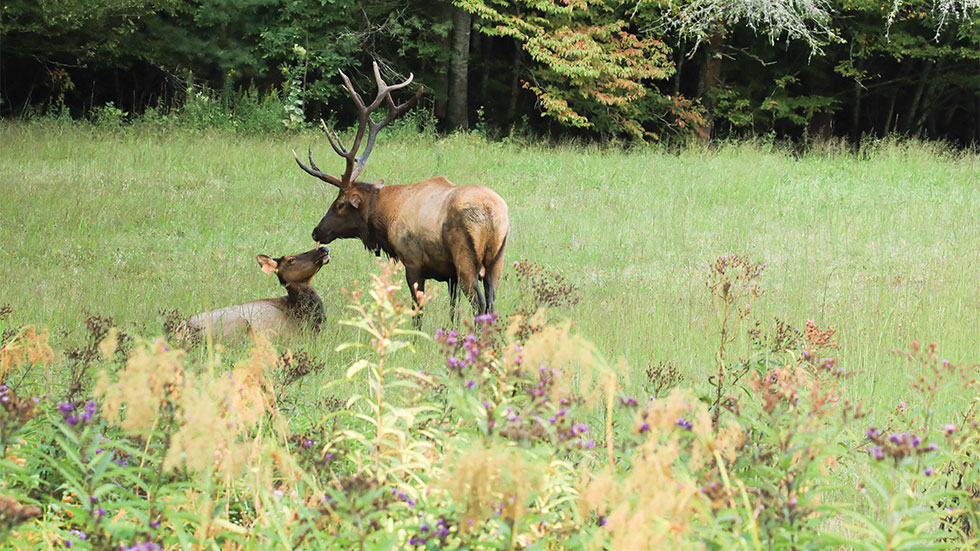This National Park Is One of the Most Biodiverse Places in the World
From the large to the small, from bears and elk to tiger snails and fireflies, wildlife abounds at Great Smoky Mountains National Park

In the ancient ridges and valleys of the Southern Appalachian Mountains, straddling Tennessee and North Carolina, is a place teeming with life. Great Smoky Mountains National Park, with its mix of microclimates ranging from damp, dense rainforest to rugged cliffs and sunny, rolling meadows, supports staggering biodiversity.
Nearly 20,000 species of animals, plants, fungi and more have been identified in the 522,000-acre park, and scientists estimate there could be another 100,000 still undiscovered, making it the most biodiverse place in North America. Of course, that also makes it one of the best places in the country to see wildlife, and it’s one reason Great Smoky Mountains is by far the most-visited of the 63 national parks in the US National Park System, with an average of 12 million annual travelers.
Whether you’re excited by arthropods or elk, fish or ferns, Great Smoky Mountains National Park is a must-see for any wildlife lover. And park visitors can do more than just gaze. A longstanding project depends on tourists to act as citizen scientists, recording photos and data on the park’s plant, animal and insect species—and sometimes even discovering new ones.
 Great spangled fritillary butterfly; Photo by Warren Bielenber
Great spangled fritillary butterfly; Photo by Warren Bielenber
SPECIES SPOTTING
The diversity of flora and fauna in the park is the result of a unique combination of history, geology and climate. Millions of years ago, when much of the continent was covered by glaciers, the deep Appalachian valleys served as a refuge for many ancient species. Now, it’s a rare kind of ecosystem called a temperate rainforest, which can receive as much as 100 inches of rain each year.
“Water is the driving force of life. Everywhere we have high biodiversity, we also have high rainfall and lots of water,” says Todd Witcher, executive director of Discover Life in America, a nonprofit partner of the National Park Service (NPS) that formed in 1998 with the goal of recording every species living in Great Smoky Mountains National Park.
But it’s a big job, and Discover Life in America has a tiny staff. “We decided a long time ago that we needed to engage the public, as they’re out in the park, to help us find things we’re looking for and new things we don’t yet know are there,” Witcher says.
 Rosebud orchid; Photo by Tom Harrington
Rosebud orchid; Photo by Tom Harrington
Visitors who want to get involved should download the app iNaturalist to their phones. Then, just take and upload photos of any plants, animals or insects. For a real challenge, Witcher suggests looking for what’s on the app’s “Smokies Most Wanted” list, including the peregrine falcon, the Appalachian tiger snail, and even unusual fungi such as witch’s butter and dead man’s fingers. If you see something that seems really unusual, photograph that, too. Since the Discover Life in America project began using iNaturalist in 2011, visitors have found almost 100 species never before recorded in the park.
“All this data is being collected not only so we know more about these things, but also for management decisions in the park,” says Witcher. “It’s hard to protect things if you don’t know they exist. The more information you have, the better able you are to conserve wildlife, even in already-protected areas like a national park.”
 Black bear mother and cubs; Photo by Luca Pfieffer
Black bear mother and cubs; Photo by Luca Pfieffer
THE PATH LESS TRAVELED
Some of the greatest wildlife sightings happen where there are fewer people. To glimpse the most impressive species in the park, take a scenic drive on a steep, winding gravel mountain road into the Cataloochee Valley in the North Carolina section of the park. The valley, surrounded by rugged 6,000-foot peaks, is a great place to see black bears, white-tailed deer, turkeys and one of the only wild elk herds in the Eastern US. (Note that willfully approaching a bear within 150 feet, or any distance that disturbs or displaces a bear, is not only illegal in the park but also dangerous.)
If you’re willing to work to escape the crowds, embark on a beautiful but strenuous hike in the park’s Cades Cove region to Gregory Bald or Spence Field, high-elevation grasslands that offer sweeping vistas and unique wildflower habitat.
To spy some of the more intriguing and uncommon species, head toward the water. Near the northern end of the park, the Whiteoak Sink Trail leads hikers through carpets of spring wildflowers to bat-filled caves and waterfalls lined with rare orchids.
 A bull elk and cow; Photo by Theron Stripling III/stock.adobe.com
A bull elk and cow; Photo by Theron Stripling III/stock.adobe.com
THE LITTLE THINGS
In Great Smoky Mountains National Park, the big animals are undeniably exciting. There’s a population of almost 2,000 black bears, which means for most of the year, chances of spotting one during your visit are high. But the true appeal of this special place can be found in the tens of thousands of species, most of them comparatively tiny.
“People get on a trail to hike, and their main goal is to get to the end and back,” says Witcher. “I encourage people to slow down and look at the small things. Look at the bugs, the flowers, the tiny plants. Stop and see the beauty of a beetle or a bumblebee.”
Each season brings new marvels. The park explodes in wildflower blooms every spring as elk calves nap in the tall grass. In summer, synchronous fireflies put on a nightly light show. Fall and winter are the domain of chubby squirrels and colorful birds. And for each known species, there may be others yet to be discovered, making Great Smoky Mountains National Park an alluring—and mysterious—place.
